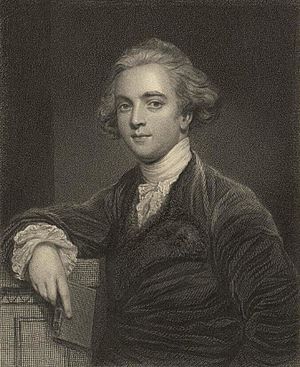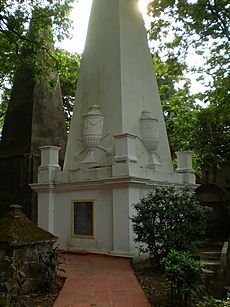William Jones (philologist) facts for kids
Quick facts for kids
William Jones
FRS FRAS FRSE
|
|
|---|---|

A steel engraving of Sir William Jones, after a painting by Sir Joshua Reynolds
|
|
| Puisne judge of the Supreme Court of Judicature at Fort William in Bengal | |
| In office 22 October 1783 – 27 April 1794 |
|
| Personal details | |
| Born | 28 September 1746 Westminster, London |
| Died | 27 April 1794 (aged 47) Calcutta |
Sir William Jones FRS FRAS FRSE (28 September 1746 – 27 April 1794) was an Anglo-Welsh philologist, a puisne judge on the Supreme Court of Judicature at Fort William in Bengal, and a scholar of ancient India, particularly known for his proposition of the existence of a relationship among European and Indo-Aryan languages, which he coined as Indo-European.
Jones is also credited for establishing the Asiatic Society of Bengal in the year 1784.
Contents
Biography
William Jones was born in London; his father William Jones (1675–1749) was a mathematician from Anglesey in Wales, noted for introducing the use of the symbol π. The young William Jones was a linguistic prodigy, who in addition to his native languages English and Welsh, learned Greek, Latin, Persian, Arabic, Hebrew and the basics of Chinese writing at an early age. By the end of his life he knew eight languages with critical thoroughness, was fluent in a further eight, with a dictionary at hand, and had a fair competence in another twelve.
Jones' father died when he was aged three, and his mother Mary Nix Jones raised him. He was sent to Harrow School in September 1753 and then went on to University College, Oxford. He graduated there in 1768 and became M.A. in 1773. Financially constrained, he took a position tutoring the seven-year-old Lord Althorp, son of Earl Spencer. For the next six years he worked as a tutor and translator. During this time he published Histoire de Nader Chah (1770), a French translation of a work originally written in Persian by Mirza Mehdi Khan Astarabadi. This was done at the request of King Christian VII of Denmark: he had visited Jones, who by the age of 24 had already acquired a reputation as an orientalist. This would be the first of numerous works on Persia, Anatolia, and the Middle East in general.

In 1770, Jones joined the Middle Temple and studied law for three years, a preliminary to his life-work in India. He was elected a Fellow of the Royal Society on 30 April 1772. After a spell as a circuit judge in Wales, and a fruitless attempt to resolve the conflict that eventually led to the American Revolution in concert with Benjamin Franklin in Paris, he was appointed puisne judge to the Supreme Court of Judicature at Fort William in Calcutta, Bengal on 4 March 1783, and on 20 March he was knighted. In April 1783 he married Anna Maria Shipley, the eldest daughter of Dr. Jonathan Shipley, Bishop of Llandaff and Bishop of St Asaph. Anna Maria used her artistic skills to help Jones document life in India. On 25 September 1783 he arrived in Calcutta.
Jones was a radical political thinker, a friend of American independence. His work, The principles of government; in a dialogue between a scholar and a peasant (1783), was the subject of a trial for seditious libel after it was reprinted by his brother-in-law William Shipley.
In the Subcontinent he was entranced by Indian culture, an as-yet untouched field in European scholarship, and on 15 January 1784 he founded the Asiatic Society in Calcutta. He studied the Vedas with Rāmalocana, a pandit teaching at the Nadiya Hindu university, becoming a proficient Sanskritist. Jones kept up a ten-year correspondence on the topic of jyotisa or Hindu astronomy with fellow orientalist Samuel Davis. He learnt the ancient concept of Hindu Laws from Pandit Jagannath Tarka Panchanan.
Over the next ten years he would produce a flood of works on India, launching the modern study of the subcontinent in virtually every social science. He also wrote on the local laws, music, literature, botany, and geography, and made the first English translations of several important works of Indian literature.
Sir William Jones sometimes also went by the nom de plume Youns Uksfardi (یونس اوکسفردی, "Jones of Oxford"). This pen name can be seen on the inner front cover of his Persian Grammar published in 1771 (and in subsequent editions).
He died in Calcutta on 27 April 1794 at the age of 47 and is buried in South Park Street Cemetery.
Scholarly contributions
Jones is known today for making and propagating the observation about relationships between the Indo-European languages. In his Third Anniversary Discourse to the Asiatic Society (1786) he suggested that Sanskrit, Greek and Latin languages had a common root, and that indeed they may all be further related, in turn, to Gothic and the Celtic languages, as well as to Persian. Although his name is closely associated with this observation, he was not the first to make it. In the 16th century, European visitors to India became aware of similarities between Indian and European languages and as early as 1653 Van Boxhorn had published a proposal for a proto-language ("Scythian") for Germanic, Romance, Greek, Baltic, Slavic, Celtic and Iranian. Finally, in a memoir sent to the French Academy of Sciences in 1767 Gaston-Laurent Coeurdoux, a French Jesuit who spent all his life in India, had specifically demonstrated the existing analogy between Sanskrit and European languages. In 1786 Jones postulated a proto-language uniting Sanskrit, Iranian, Greek, Latin, Germanic and Celtic, but in many ways his work was less accurate than his predecessors', as he erroneously included Egyptian, Japanese and Chinese in the Indo-European languages, while omitting Hindustani and Slavic. Jones also erroneously suggested that Sanskrit ‘was introduced [to north India] by conquerors from other kingdoms in some very remote age’ displacing ‘the pure Hindi’ of north India.
Nevertheless, Jones' third annual discourse before the Asiatic Society on the history and culture of the Hindus (delivered on 2 February 1786 and published in 1788) with the famed "philologer" passage is often cited as the beginning of comparative linguistics and Indo-European studies.
The Sanscrit language, whatever be its antiquity, is of a wonderful structure; more perfect than the Greek, more copious than the Latin, and more exquisitely refined than either, yet bearing to both of them a stronger affinity, both in the roots of verbs and the forms of grammar, than could possibly have been produced by accident; so strong indeed, that no philologer could examine them all three, without believing them to have sprung from some common source, which, perhaps, no longer exists; there is a similar reason, though not quite so forcible, for supposing that both the Gothic and the Celtic, though blended with a very different idiom, had the same origin with the Sanscrit; and the old Persian might be added to the same family.
This common source came to be known as Proto-Indo-European.
Jones was the first to propose the concept of an "Aryan invasion" into the Indian subcontinent, which according to Jones led to a lasting ethnic division in India between descents of indigenous Indians and those of the Aryans. This idea fell into obscurity due to a lack of evidence, but was later taken up by amateur Indologists such as the colonial administrator Herbert Hope Risley.
Jones also propounded theories that might appear peculiar today but were less so in his time. For example, he believed that Egyptian priests had migrated and settled down in India in prehistoric times. He also posited that the Chinese were originally Hindus belonging to the Kshatriya caste.
Jones, in his 1772 Essay on the Arts called Imitative, was one of the first to propound an expressive theory of poetry, valorising expression over description or imitation: "If the arguments, used in this essay, have any weight, it will appear, that the finest parts of poetry, musick, and painting, are expressive of the passions...the inferior parts of them are descriptive of natural objects". He thereby anticipated Wordsworth in grounding poetry on the basis of a Romantic subjectivity.
Jones was a contributor to Hyde's Notebooks during his term on the bench of the Supreme Court of Judicature. The notebooks are a valuable primary source of information for life in late 18th century Bengal and are the only remaining source for the proceedings of the Supreme Court.
View on Historical Timeline of Biblical Events
Jones said that "either the first eleven chapters of Genesis ... are true, or the whole fabrick [sic] of our national religion is false, a conclusion which none of us, I trust, would wish to be drawn." (1788, 225)
He also said that "I.. . am obliged of course to believe the sanctity of the venerable books [of Genesis]" (1788, 225)
Jones "traced the foundation of the Indian empire above three thousand eight hundred years from now" (Jones, 1790). Jones thought it was important that this date would be between Bishop Usher's creation date of 4004 B.C.E. and the Great Flood that Jonas considered to be in 2350 B.C.E.
Encounter with Anquetil-Duperron
In Europe a discussion as to the authenticity of the first translation of the Avesta scriptures arose. It was the first evidence of an Indo-European language as old as Sanskrit to be translated into a modern European language. It was suggested that the so-called Zend-Avesta was not the genuine work of the prophet Zoroaster, but was a recent forgery. Foremost among the detractors, it is to be regretted, was the distinguished (though young) orientalist William Jones. He claimed, in a letter published in French (1771), that the translator Anquetil-Duperron had been duped, that the Parsis of Surat had palmed off upon him a conglomeration of worthless fabrications and absurdities. In England, Jones was supported by Richardson and Sir John Chardin; in Germany, by Meiners. Anquetil-Duperron was labelled an impostor who had invented his own script to support his claim. This debate was not settled for almost a century.
It is not curious that Jones didn't include Iranian in his naming of the cluster of Indo-European languages, since he hadn't any idea about the relationship between Avestan and Sanskrit as two main branches of this language group.
Chess poem
In 1763, at the age of 17, Jones wrote the poem Caissa, based on a 658-line poem called "Scacchia, Ludus" published in 1527 by Marco Girolamo Vida, giving a mythical origin of chess that has become well known in the chess world. This poem he wrote in English.
In the poem the nymph Caissa initially repels the advances of Mars, the god of war. Spurned, Mars seeks the aid of the god of sport, who creates the game of chess as a gift for Mars to win Caissa's favour. Mars wins her over with the game.
Caissa has since been characterised as the "goddess" of chess, her name being used in several contexts in modern chess playing.
An Elegiac Poem
Maurice, Thomas. (1754-1824), published An Elegiac Poem in 1795, full title An Elegiac Poem, sacred to the memory and virtues of the honourable Sir William Jones. Containing a retrospective survey of the progress of science and the Mohammedan Conquests in Asia.
Oration by Hendrik Arent Hamaker
On 28 September 1822 the Dutch orientalist Hendrik Arent Hamaker, who accepted a professorship at the University of Leiden, gave his inaugural lecture in Latin De vita et meritis Guilielmi Jonesii (The Life and Works of William Jones)(Leiden, 1823).
Memorial
There is a wall memorial to him in the crypt at St Paul's Cathedral.
See also
 In Spanish: William Jones (filólogo) para niños
In Spanish: William Jones (filólogo) para niños

